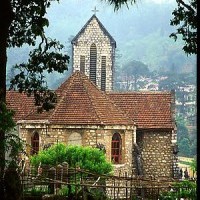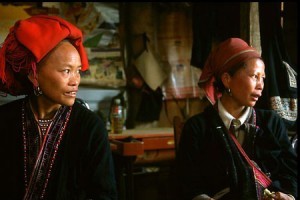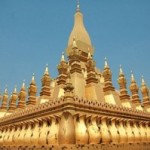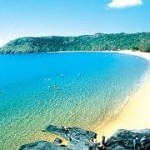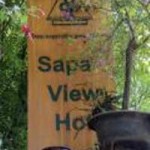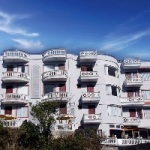Where to stay in Sapa
Sapa is a beautiful, mountainous town in northern Vietnam along the border with China.
Located at 1650 m above sea level in Vietnam’s remote northwest mountains, Sapa is famous for both its fine, rugged scenery and also its rich cultural diversity. Sapa is an incredibly picturesque town that lies in the Hoang Lien Son mountain range near the Chinese border in northwestern Vietnam, known as “the Tonkinese Alps”. Sapa and its surrounding region is host to many hill tribes, as well as rice terraces, lush vegetation, and Fansipan, the highest peak in Vietnam. However, as a result of a recent surge in popularity Sapa has rapidly become a tourist hotspot where money is the new drug of choice. Don’t be put off by the rush, your explorations of the surrounding countryside will be worth the trouble.
You can book sapa tours with Sapa Travel office in the town
Ethnic Minorities
Many ethnic minorities live in and around Sapa. Excluding the Kinh people or ethnic Vietnamese, eight different ethnic minority groups are found in Sapa; H’mong (pronounced Mong), Dao (pronounced Yao), Tay, Giay (pronounced Zai), Muong, Thai, Hoa (ethnic Chinese) and Xa Pho (a denomination of the Phu La minority group). However, the last four groups comprise less than 500 people in total. The population of the district is estimated at 31,652 (1993) of which 52% are H’mong, 25% are Dao, 15% are Kinh, 5% are Tay and 2% are Giay. Around 3,300 people live in Sapa town, the remainder are peasant farmers distributed unevenly throughout the district.
Many older women in particular make items such as ethnic-style clothes and blankets, to sell to tourists. Striking up a conversation with them can be very rewarding and their spoken English is impressive. Sadly, however, doing this in Sapa town itself will sometimes lead to a scrum as a multitude of vendors taste a potential sale.
Children from these ethnic minorities often begin to support their families financially through selling trinkets to tourists. Do not encourage this by buying from children – Buy from adults. They peddle small metal or silver trinkets, embroidered pillow cases and friendship bands in the main town, and often walk for several hours from their surrounding villages to reach the town. At the end of the day, some take a motorbike ride back to their village, some walk home and some sleep in the market.
Girls and boys get married young (around 15-18) and often have two children by the time they are 20 years old. Poverty has led to a great number of girls leaving their villages each day to go selling in Sapa town, and depending on their luck, may only have one meal per day.
Weather
In winter (the 4 months November to February), the weather in Sapa is invariably cold, wet and foggy (temperatures can drop to freezing and there was snow in 2011). Travellers have rolled into town on a glorious clear day and proceed to spend a week trapped in impenetrable fog. When it is like this there really isn’t very much to do. Also the rice paddys are brown & empty (they are planted in spring), the paths very muddy & slippery & the glorious vistas of summer are completely hidden in the mist. If you chose to visit in winter, bring along warm clothes or prepare to be cold and miserable, as many hotels do not have efficient heating in their rooms. During that time, more upmarket hotels that do have heating fill up quickly, so make advance reservations if you can afford not to freeze. (Or don’t go there in winter time). It rains very often during the month of August, especially in the mornings.
Travel Tips
Bear in mind that some of the minorities do not wish to have photos taken of them. Ask permission beforehand.
Bring along a poncho. You can also buy a cheap one in the many shops around.
Rubber boots and trekking shoes can be rented from some shops or perhaps at the hotel you are staying in. However, do bear in mind that they have limited sizes.
Do buy some hand made items direct from the ethnic minorities, especially if you have enjoyed a good conversation or received help from them. Though they do charge slightly more than the shops, bear in mind that the majority of them are very poor and depend on tourist money to survive.
Get in
By train
From Hanoi it is a 9-hour train journey to Sapa.
Vietnam Rail operates some of the cars, but other cars in the train are operated by private companies (Tulico, Ratraco, Fansipan, Friendly, Orient Express and Victoria Hotels, and many others). Some of these cars are significantly nicer than the standard cars. You may need to arrange with a travel agency to get tickets on these tourist cars, but any traveller can purchase tickets for the VNR cars at the Hanoi train station. Warning: several of these cars are not significantly better than standard Vietnamese sleeping cars though, and still substantially more expensive. Pumpkin second class is actually a VNR car booked via this company. Even Pumpkin first class only has a squat toilet (although a sign above the toilet door says: “western style toilet”!).
Cheaper tickets, especially in hard sleeper class, can be hard to come by at times, as tour companies and travel agents will snap up these to first on their own customers (too frequently a promised soft sleeper berth will turn into a hard sleeper when it comes time to board). To avoid rip offs better go to the train station by yourself and get the ticket from the ticket office. This is the only way to make sure that you will get what you have paid for. Travel Agencies in Vietnam are known for their bad business practice. Although one cannot be assured of finding a place, it is often possible to arrive at the station a short while before boarding time, as there are usually young men hanging around trying to hawk unfilled berths at the last minute. The price of these tickets will fall dramatically as departure time draws near.
Prices vary according to both the type of seat purchased and the season during which you are travelling. The times around Vietnamese holidays are particularly expensive and tickets cannot be assumed available for same day travel, so book ahead if possible. Travellers are highly recommended to purchase a berth in a soft or hard sleeper car, though the trip in soft seat class is not intolerable. For a bed, expect to pay in the area of 530,000-625,000 dong (one-way). For a soft seat, expect to pay 320,000 dong for one-way (Mar 2013). There is usually a dining car serving good, surprisingly affordable noodles (20,000 dong) and rice porridge (15,000 dong), but it’s always wise to bring your own snacks and drinks as well.
The train ends at Lao Cai. From there, dozens of shuttle buses will be waiting outside the station to take you the remaining distance to Sapa, usually at a ‘fixed’ rate of 60,000 dong (February 2013). It’s often possible to bargain down to 50,000 dong (March 2013) or lower, depending on demand. The ride is about an hour of beautiful views (if the weather is good, it may be an hour of fog at other times) more than 1000 meters up into the mountains.
You may want to book a return ticket when you buy your outward journey, as picking up tickets in Lao Cai is harder than in Hanoi. Ticket counter at the train station is open 8 to 10 am and from 2 pm The staff do not speak as much English, and they possibly only sell tickets for travel on the same day so sleepers may already be sold out unless you go first thing in the morning. Pay attention to the time of your return train Trains leaving Lao Cai around 20h00 will arrive in Hanoi at around 5h00 early in the morning. If you don’t make prior arrangements to return at an early hour, you may find yourself sitting outside of your hotel, waiting for the desk to open.
By bus
Bus station in Sapa is in the center, near the lake. Sleeping buses to Hanoi cost 300000 dong (Mar 2013). Most buses you can book through travel agents for almost the same price. Minibuses to Lao Cai drive around looking for passengers, if you get on empty minibus it could take up to one hour. They drive very slowly, so it could take one hour for 30 km journey. Price for locals seems to be around 40 or 50 thousands. Bargaining with them is not recommended. I agreed for lower price with them, but in the half way they started to collect money and asked for higher rate. I payed just agreed amount and they forced me out of the bus in a half-way. Good option to get between Lao Cai and Sapa is to go near the beginning of the road and hitchhike for private car. Many vietnamese tourist travelling by their car in this route, and will take you for free or 30-40 thousands dong, it is faster even including time needed to walk to the road. Road to Dien Bien Phu is in bad condition, bus costs around 230000 dong (Mar 2013) It is small and crowded. Journey takes more than 10 hours. If you take night bus to Dien Bien Phu, there is connecting bus to OudomXay in Laos, which seems to wait for arrival of Sapa bus even if it is late.By motorcycle
Sapa can also be reached by motorcycle from Hanoi by a variety of routes. The most direct route takes at least ten hours for first time riders, though local expats often brag about making it in less. Bikes can be rented in Hanoi for unguided passage, or local guides can lead the way. Along the way be sure to top up with fuel regularly, as petrol stations sometimes prove few and far between. It’s also useful to note that fuel vendors in small towns often mix the petrol with other liquids such as alcohol or bio-fuels, and such fuel should be bought and used only when there are no alternatives.
Get around
Anywhere in the main village of Sapa can be reached on foot, and the town is small enough that you’re not likely to get lost. A basic map will be good enough for most travellers.
The way to CatCat is taxed 40,000 dong,while the way to Ban Ho & Lao Chai villages are taxed 40,000 dong in one ticket. The way to Ta Phin village is taxed 20,000 dong as well.
Tourists intending to trek to the various villages through the paddy fields should be prepared with good trekking shoes or rubber boots, a walking stick and extra clothing kept in a waterproof bag. Depending on the season, the rice fields, which are build in terraces, can be very muddy and slippery. If one does not wear shoes which enables a good grip in mud, one is likely to keep slipping and falling or even sliding down the slopes! As the paths are also taken by water buffalos, excrement can be found everywhere. Walking sticks can be bought from children from the ethnic minority groups at about 5,000 dong. These enterprising children cut sturdy bamboo and sharpen one end to turn them into sturdy sticks.
For the less adventurous, some of the villages, such as Lao Chai Village, is accessible via jeep, motorcycle and van.
See
Sapa is a charming mountain town, surrounded by picturesque mountains and rice terraces. Great views of the area can be had (weather permitting) from the nearby hills. One of these has been built up into a tourist attraction (“Ham Rong Resort”) with various gardens (orchid, European), ethnic minority dance performance areas, viewpoints, and restaurants. It’s a short walk south from the central square and then up some stairs. Entrance is 70,000 dong.
If you got time then it’s worth going to the “Sa Pa Culture Museum” (Open daily 7:30AM-11:30AM,1:30PM-5:00PM.~Admission free,but donations accepted~) where you can learn about the history of Sa Pa and the custumes & traditions of the Etnic groups of Sa Pa.The museum is located behind the Tourist Office.
It’s also worth to check some of the colonial buildings left by the French colonialists such as the church,the square and townhall building. While walking in the mountains you will encounter many hill tribes such as the Red Zao tribe.
Do
The ethnic village of Cat Cat is a few kilometers’ walk from Sapa. You’re not likely to get lost – just walk down the road out of
Sapa, which should be marked on maps, and after a while you’ll find a path which descends the hill to your left. This path runs through the village before climbing another hill back to the road. This walk provides a good chance to observe Vietnamese farming and farm animals, and there are excellent views. The walk back up can be difficult (it is steep in parts) but once you get back onto the road there are plenty of enterprising locals ready to take you back to Sapa on motorbikes (40,000d per person per bike). Entrance to the village is currently 40,000 VND. Elderly persons should skip this Cat Cat trek. Nothing much actually. Walking down you see a few home cottage industries like fabrics, carving , art shops. In the middle of the trek, you come to a restplace, with a so-so waterfall, and a supposedly minority village which is a block of dwelling, like compartmentalised units in one building, and no sign of any activity. Nice stroll if you have a morning or afternoon free.
Sign-up for a trekking trip that enables you to stay overnight at one of the villages. The homestay experience is not uncomfortable (some homestays have hot water showers, while some don’t. Ask in advance if this is important to you) and an enriching one. Bring a sweater, as the villages can be very chilly at night and there are no heat sources of any kind except for the cooking fire in the kitchen. Thick blankets will be provided when you sleep. These treks can be purchased in Hanoi as part of a package, or you can ask for private treks for your party, at USD40 per day(as of 2012. See Sapa Sisters below). Be aware, however, that most trekkings organized by Vietnam people do not really respect the guides (who will mostly be members of the ethnic minorities). Some local organizations (like Sapa Sisters, see below) guarantee a good income for the local people, not only for the Hanoi-based tour organizations.
Heaven’s Gate. The mountains will take your breath away. Join a tour or go by rented motorbike. Get directions and a map from the very friendly girls at the tourist centre right in the middle of the town’s square. If you go on tour it will be a half day thing with a waterfall nearby thrown in. This waterfall has its own charm. Viewing the mountains is free, though there is a small charge to enter the waterfall. Make sure you bring along wide-angled cameras for the mountains.
A 5-minute walk from the church will bring you to Sa Pa lake where you can rent a pedal boat for 40,000 dond/30 min or 80,000 dond/hour. Note that the pedal boats are available only on weekends& good weather days.
Sapa Sisters Trekking Adventures (Sapa Sisters), Sapa Sisters is a highly recommended trekking company owned by local Hmong women. The guides work with travelers to decide treks in and around the Sapa Valley including multiple night stays and trips to local markets. You can only book treks via their website or at Family Guest House.
First Choice Sapa Tour
“The Unforgettable Lao Cai – Sapa Experience” In July 2012, 3 of us had this wonderful trip in Lao Cai & Sapa, arranged by Alex of Pearl Suites Hanoi Hotel in the Old Quarters as part of our Hanoi Tour itinerary. The considerably comfortable over night train ride (9pm to 5.30am the next day) was a unique experience whether one enjoys it or not. That morning we visited the very interesting Bac Ha wet market – a chance for us to expose ourselves to the H’mong people’s colourful culture, intricate handicraft and not forgetting their unique traditional food. Bac Ha market was our favourite destination, and for those who want to grab some souvenirs; this is a great place. The rest of the day was spent in Sapa itself- 1 hour’s car ride from Lao Cai. Thanks to Alex – he put us up in a beautiful hotel in rooms with balconies which oversee the beautiful valleys. After dinner, we visited the sweet family of our tour guide, Quang, our new friend. A night tour of Sapa town & dropping in at the night market was an added bonus.
The next day from 8.30am till 3.30pm,we went on a long trek through the valleys, visiting flower H’mong, black H’mong & Dzay houses, where we sampled corn wine, tea & tobacco. It was a total of over 18,000 steps on foot but we totally enjoyed it. Besides the much needed exercise, we feasted our eyes on the astounding beauty of the scenery en-route. Tourists must bring the right shoes, a good camera & some drinking water. The H’mong people tend to escort tourists all the way, offering their service such as carrying your bags, but you have to return their favour later by buying from them. Sapa town itself is a beautiful high altitude small town, basically in French architecture, where it’s alleged to have four seasons in a single day.The many restaurants, bars & bistros offer different European dining experiences. But it’s its cool weather, the serenity, the tranquillity & the beauty of its surroundings which made us regret we did not spend an extra day in Sapa.. Email to First Choice at sales@firstchoice.vn
Buy
It is possible to change money, traveler cheques and get cash advance on credit cards at the bigger Hotels in Sapa. Furthermore, there are ATMs on the main street that now accept all major cards such as Visa, Mastercard or the Maestro network.
Make sure that the foreign currency notes you bring along to Sapa are as new and crisp as possible. It is very hard to obtain the local currency with tatty notes. Some hotels will reject the money exchange request. There have been reports of shops taking customer’s new crisp notes, switching them with taped up cut ones, and insisting that were the ones the customers gave them.
The usual endless supply of nearly identical tourist trinkets is available at every turn. Although Sapa is famous for its embroidery. There are two types: handmade and machine made. It is easy to tell the difference. Buying direct from the maker is preferable, although prices are highly elastic. When bargaining, try to find out how long it took to make the piece. If you want machine made products, you are better off buying them in the shops – It pays to shop around for the right pair of reproduction Montagnard earrings or fake handicrafts.
The various markets sell clothes, blankets, etc. with colorful designs traditional to the various ethnic minorities in Sapa. Take note that the dye used to give a blue color stains the fingers (and not only the fingers) – which is why many of the women who make them have darkened fingertips. When you wash these clothes the colour will run. (To avoid this, soak them in cold salty water, and make sure you pack them carefully in your bag to take home.)
Be careful buying batteries as some people will sell them with no juice.
Eat
There are more restaurants than one could stomach along the main strip, Pho Cau May; they all have nearly the same menu, with many of them offering, oddly enough, Italian as well as Vietnamese fare. Tread with caution.
Delta restaurant – a top-end restaurant. The food is a sad attempt at Italian food. The pizzas were terrible (and sweet?) but the pasta was a bit better. Too expensive: from US$5 for a pizza. Same for pastas. Wine is very very expensive.
Rose Garden Sapa – a middle-ranged restaurant. The restaurant is located on phanxipang street, on the way to Cat Cat Village. They have freshly baked baguettes and hamburgers right off their own bakery. The desserts – ice cream, cakes and cookies are sweet delicacies yet at an affordable price.
Le Gecko Sapa
Managed by the little Nam Dinh boy, it offers Pizza, Sandwiches and Pasta. The restaurant regular and popular “special of the day” 5$ menu wich consist of Sapa Soup, spring rolls, principal plate, bowl of rice + dessert. Breakfast, Snack, Burgers, Steaks, Soups, Salads, French & Vietnamese, Pork, Vegetarian, Chicken, Beef, Sea Food, Hot Pot and many others Sapa Specialities. Find it at 4 Ham Rong street.
Little Sapa – a popular, low-priced restaurant on the hill leading out of the main tourist hotel area. Serves outstanding local and decent western dishes to a mixed local/foreign clientele. Features some unique dishes in addition to the fixtures available at any other Sapa restaurant. Try the H’Mong King Style chicken. 18 cau may st.
Baguettes & Chocolate – a café specializing in delicious French pastries. They serve both European and Asian meals as well. Run as a vocational school for disadvantaged youths. Up the stairs northwest of the central plaza. Expect patchy service from the disadvantaged youth.
On the corner facing out onto the lake in the central part of town (up the hill from the tourist hotel area) is a pleasant shop selling local fare, they offer a partly-translated menu with fair prices (10,000-30,000 dong).
At the market – Foodstalls selling good noodlesoup for VND 10.000, fried rice for VND 15.000 and the other usual Vietnamese fare for around VND 30.000. Further more it’s a great experience to dine with the locals!
Bombay Indian, 36 pho cau may. Very good North Indian food, with many options for vegetarians. Mains are 4-8USD.
The Hill Station, 07 Muong Hoa,. Fine wine, cheese and cold cuts. Home made hams and pâté. Punto Italia coffee.
Drink
Hmong Sisters Bar – Close to the Sapa Bamboo Hotel. Has a pool table, darts and a computer with free Internet.
Sapa O’Chau Cafe, 08 Thac Bac Street (Up the steps northwest of the central plaza and turn right), ☎ 0915351479, [5]. Boutique school themed cafe serving guest teas & coffees, hemp milk, smoothies and pancakes. Free wifi. Student run. Great place for like minded people and volunteers.
Sleep
Keep in mind that in Sapa, as in many other provinces of Vietnam, it is the law that you must turn over your passport to your hotel/guesthouse/hostel. However, a photocopy of the main page and your visa should suffice, and if they refuse, simply tell them your real copy is in Hanoi getting a visa extension.
A near-endless supply of cheap rooms are available in the touristy area down the hill from the town centre, and generally a flock of young men and women will leap on you the moment you arrive with offers from US$3 on up (price quoted for a double).
Ly Tam May Quang’s Homestay, Doi 1 – Ta Phin village, ☎ 01666924727,. Although not located in Sapa but rather 15 km from the town itself, in Ta Phin village. A nice and friendly little homestay run by english, french and vietnamese speaking owners. They can cook any food you like and propose REAL herbal baths at a decent price. US$3.5.
Fansipan View Hotel, Xuan Vien St, ☎ (+84-203) 873 579, A nice and relaxing hotel with boutique interiors.
Hoang Ha Sapa Hotel, Thac Bac St, ☎ + 84 203 872 535, Conveniently located in the center of Sapa Town in Lao Cai, Vietnam, overlooking the beautiful Muong Hoa Valley. All rooms are equipped with Large balcony with landscape view, Fireplace, Cable TV and Free Wi-Fi Internet access. Some of its facilities and services are Meeting room, Restaurant, Room service and Free high-speed Internet access.They offer a bus to the hotel but you have to pay and if you arrive on the early train you sit in the station car park until later trains arrive. The scare stories about overcharging by minibus drivers seemed wrong- it is 50,000 dong everywhere. They also don’t want to check you in until 1-2pm. Western breakfast poor.
Green Bamboo Sapa – a hotel with an old wing located near the entrance of the town. It serves a cheap and good breakfast at US$2.50. A night’s stay at the main hotel will cost US$25. A room in the old wing will cost about US$10. Rooms in the main and old wing of the hotel, as long as not on the ground floors, will offer a breathtaking view of the Fan Xi Pan mountains.
Little Sapa – basically a restaurant located near the market, it also serves as a hotel for long-stay travellers, costing US$60/month. Big rooms with balconies, TV, hot water.
Lotus Hotel – located only a few meters from the Royal Hotel. Nice rooms, tea, tv, hot water, restaurant and for some rooms, a fireplace and a nice view. US$4-7. Week-ends are naturally more expensive. The staff is a little bit cold. Hotel closes at 11pm.
Pumpkin Hotel, 42 Cau May str, ☎ 020.872.350. Very friendly and helpful staff. Good sized rooms with desks and computers. Beware the hotel may attempt to charge extra for a space heater at a rate of 150.000vnd. (For the electricity, of course.) If you are staying here as a part of an ET Pumpkin tour make sure to get assurances that your space heater will be included in the price. Get it in writing if you can. $18.
Red Dragon Pub, Muong Hoa street (Close to the Holiday Hotel).
The Royal Hotel – located at the bottom of the main street. The rooms provide a nice view over the valley and many open onto a small balcony. It has an attached café offering standard traveller fare (banana or chocolate pancakes, as always in Vietnam, feature) and can help you out with travel arrangements. Rooms with a view over the valley start at $15US (double) while rooms looking back over the town are $12US.
Sapa Global Hotel, No. 18 Pham Xuan Huan St., Sapa Town (across from church, near Central Park), ☎ 020 350 2242. checkin: any time; checkout: 12pm. Located smack in the center of Sapa, this cozy hotel full of rustic, old world charm has 20 newly renovated rooms all with heating, hot water, satellite TV and wifi. Free internet access is available in the lobby. Breakfast included. Trekking and other tours can be arranged at reception. $15-40USD.
Thai Binh Sapa Hotel, Ham Rong Street, Sapa Town, Lao Cai Province, Vietnam (From market, walk straight up from the left of the church. Turn left at the end of the street.), ☎ +84 (020) 3871212, . checkout: 1200. Located at quiet part of Sapa and within 5mins walk from market and restaurant street. Free internet in lobby and Wi-Fi in rooms. Electric heater, electric mattress available in the room. The hotel boss (a local teacher / education officer), and a lady receptionist is very friendly and speak good english. They are able to provide local tour, buy train tickets (Lao Cai train station), and transport to and from Lao Cai train station. US$22 – US$25.
Topas Eco Lodge, (30 min drive south of Sapa), Perched on beautiful grounds on a hill with stunning views of the surrounding valley. Spacious, detached bungalows, each with their own balcony, making a comfortable double, or can probably even accommodate a small family. The eco part of the title comes partly through the lodge hiring local staff and using solar power and hot water in all of their bungalows. About US$99 per night for a detached bungalow.
Mountain Bar & Pub, 02 Muong Hoa, Sapa, Lao Cai (Near Royal Hotel), ☎ 0983889798. Good Bar in Sapa with many flavour Shisha. Good place to drink
Family Guesthouse, 028 Muong Hoa, Sapa, Lao Cai (Near edge of Sapa town), ☎ (+84 203) 872310, (+84)01662624308. Clean but very spartan rooms at the very edge of town. Rooms have no heat, so gets very chilly at night. There are 2 great things about this hotel: a very helpful, honest receptionist who speaks good English, and the rooms have great views of the Fansipan mountains.
Sapa Rooms, 18 Phan Xi Pang Street, Sapa, Lao Cai, ☎ +84 (020) 650 5228, [13]. Great little boutique hotel with a ground floor restaurant that serves a wide range of good dishes and has free WiFi. They can arrange tours with local guides and optional home stays, with a percentage of the profits going directly to support local community projects and schools. Also rent motorbikes, offer cooking classes, opportunities to volunteer in local communities, accepts clothing donations, etc.
Sapa cozy hotel. Never stay in this hotel. The guy quoted me 8 dollar for a room and when i checked out, demanded 10 dollars claiming it is a bigger room. I refused and said it is their mistake in giving me the room and they have a whole day to inform me. After that, he charged me vnd20,000 for 2 packets of instant coffee. He just tried to get as much money from me as possible. Totally dishonest guy.
Homely Villa in Sapa (Villa for Best Experience in Sa Pa), . checkin: 2:00pm; checkout: 12:00pm. Located on a 6000sqm native plant garden, this villa has got an indoor fireplace to keep you warm and also Wi-Fi Internet. It also offers free transfer to and from their BnB to town which makes travelling convenient. More importantly, within walking distance to the villages of H’mong and Red Dao ethnic people, it is an excellent starting point to explore the charm of Sa Pa. USD$45.
Victoria Sapa Hotel: top-end luxury accommodation in Sapa
Get out
If you are looking to take the train to Hanoi from Lao Cai, your hotel can probably organise to get you onto a minibus. If you’re looking to pay less than the usual rate (50,000 dong, February 2012), you’ll have to walk to the central park area where minibuses and vans cruise for passengers and are willing to bargain to the rigth price of 40,000 dong(March 2012). Be reminded that getting on an empty (or half-empty) bus will mean waiting for more passengers, regardless of whatever departure time is promised by the driver and his ever-present crew of buddies who’re hanging around.
The local tourist office also sells sleeper buses (350,000d.) from SaPa to Hanoi. The bus is new and luxurious, however the bus driver will drop you out in the western outskirts of Hanoi, despite the assurances that they will drop you at the airport or at the train station in Hanoi. If you should find yourself in this situation, there is a bus station around the block called Xe Ben Khach My Dien, where you can get on bus #34 towards Hanoi centre for 3,000 dong. Alternatively, taxis will quote you 200,000 dong to take you to the Old Town. The representative at tourist office may tell you that all train tickets at Lao Cai are sold out. Be sure to check at Lao Cai, or even better in Hanoi before arriving in SaPa.
Small step-through Honda motorcycles can be rented in the touristy parts of town, as well as near the gas station on the road leading to Lao Cai, for US$3-6 depending on the amount of time rented and your bargaining skills (i.e. determination). Day trips into the surrounding countryside can be very rewarding, although a good up-to-date map and a healthy dose of caution is required as roads are winding and populated with all manner of conveyance, and markings can be misleading as the North undergoes some odd town-relocation schemes.
You may be able to hire a guide, or join a group, to visit the various ethnic villages in the area by jeep and/or boat. The various travel agencies in town, or the people at your hotel, should be able to give details.
For those looking to go farther afield, the road to Dien Bien Phu is simply stunning and makes for a fantastic 4-5 day return trip. Always give yourself plenty of daylight hours to return home, however, as highly changeable weather could strand you in dense fog without notice, especially during the winter months. There is also a bus to DBP which runs from the tourist office at 7.30am each day, and costs $11.
Try to arrive at the Lao Cai with a couple of hours to spare and you can zip to the border (5 minutes away) on taxis (cheaply). The locals do it regularly because it’s like one big bazaar with carnival atmosphere overflowing with merchandise of everything under the sun.





